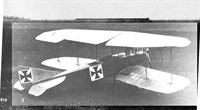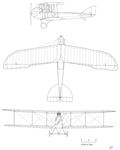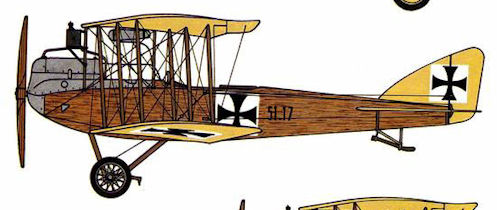P.Grosz, G.Haddow, P.Shiemer Austro-Hungarian Army Aircraft of World War One
Oeffag 50.02
The Oeffag C.I series 51 production contract stipulated that the 50.02 prototype was to be delivered on 15 June 1915. Oeffag documents record the 50.02 as "completed" in December 1915, an indication that during the course of flight testing extensive modification was required. Dimensionally similar to the 50.01, the 50.02 was fitted with a conventional three-bay wing cellule and powered by a 160 hp Daimler engine. On entering service, the 50.02 was assigned to Flek 6 and Schulkompagnie 1. After repair in 1917, it was assigned to Flek 10. While on an airmail run between Cracow and Lemberg, a carburetor fire caused the 50.02 to crash land and burn at Rzeszow, Galicia on 22 May 1918.
Oeffag 50.02 Specifications
Engine: 160 hp Daimler
Wing: Span Upper 14.58 m (47.83 ft)
Span Lower 13.90 m (45.60 ft)
Chord Upper 2.30 m (7.55 ft)
Chord Lower 2.00 m (6.56 ft)
Dihedral Upper 2 deg
Dihedral Lower 2 deg
Sweepback Upper 9 deg
Sweepback Lower 9 deg
Gap 1.92 m (6.30 ft)
Stagger 0.17 m (0.56 ft)
Total Wing Area 54 sq m (581 sq ft)
General: Length 8.60 m (28.21 ft)
Height 3.27 m (10.73 ft)
Useful Load 488 kg (1076 lb)
Loaded Weight 1350 kg (2977 lb)
Maximum Speed: 120 km/hr (74.5 mph)
Climb: 1000m (3,281 ft) in 7 min 30 sec
Oeffag C.I Series 51
The LFT awarded Oeffag its first production contract on 17 July 1915, specifying one prototype (50.02) and 24 C.I biplanes numbered 51.01 to 51.24. Four production machines were in assembly in December 1915. The first C.I (51.01) arrived at Aspern for flight testing in January 1916. Acceptance was delayed until 24 March 1916 because a suitable company test pilot was not available. The last aircraft were accepted in June 1916.
The C.I, powered by a 160 hp Daimler engine, was assigned to the newly established Fliks 25 and 27 in April-May 1916 and later to Fliks 9, 11, and 18 on the Galician (Russian) plain where the terrain was flat and undemanding. Popularly known as the "Skodaflugzeug", the C.I was a stable, safe, and solidly-constructed aircraft, regarded as ideal for radio-spotting duties because of its low speed and pleasant flight and landing characteristics, but for air combat it was considered sluggish. In late 1916, the C.I was withdrawn; some were equipped with dual controls and issued to Fliks 6, 14, 20, 23, 31, 43, and 49 and to Fleks 6, 10, and 11 as advanced trainers. Twenty-two C.I trainers were still in service as of September 1917, and eight in August 1918 - some flying airmail between Aspern and Lemberg. Seven survived the war and were offered for sale by the Austrian government in 1920.
Oeffag C.I Series 51 Specifications
Engine: 160 hp Daimler
Wing: Span Upper 14.58 m (47.83 ft)
Span Lower 13.90 m (45.60 ft)
Chord Upper 2.30-2.00 m (7.55-6.56 ft)
Chord Lower 2.00 m (6.56 ft)
Dihedral Upper 2 deg
Dihedral Lower 2 deg
Sweepback Upper 9 deg
Sweepback Lower 9 deg
Gap 1.93 m (6.33 ft)
Stagger 0.17 m (0.56 ft)
Total Wing Area 54 sq m (581 sq ft)
General: Length 8.40 m (27.56 ft) (less propeller)
Height 3.27 m |10.73 ft)
Track 2.20 m (7.22 ft)
Loaded Weight 1350 kg (2977 lb)
Maximum Speed: 125 km/hr (78 mph)
Climb: 1000m (3,281 ft) in 7 min
E.Hauke, W.Schroeder, B.Totschinger Die Flugzeuge der k.u.k. Luftfahrtruppe und Seeflieger 1914-1918
50. Flugzeuge der Österreichischen Flugzeugfabrik A.G. (Oeffag) Wiener Neustadt
50.02 Oeffag DD Prototype für C.I Dm 160
51.01 - 51.24 Oeffag C.I Dm 150
 |
E.Hauke, W.Schroeder, B.Totschinger - Die Flugzeuge der k.u.k. Luftfahrtruppe und Seeflieger 1914-1918
|
| Oeffag C I 51.17 Flik 27
|
 |
E.Hauke, W.Schroeder, B.Totschinger - Die Flugzeuge der k.u.k. Luftfahrtruppe und Seeflieger 1914-1918
|
| Oeffag C I 51. Lemberg Herbst 1918
|
 |
P.Grosz, G.Haddow, P.Shiemer - Austro-Hungarian Army Aircraft of World War One /Flying Machines/
|
The Oeffag 50.02, the prototype of the C.I series 51, differed from the 50.01 primarily in having a conventional wing cellule and modified tail surfaces.
Oeffag 50.02 in Wr. Neustadt. Werksflugfeld 1916, Versuchsflug zur Ba 51
|
 |
P.Grosz, G.Haddow, P.Shiemer - Austro-Hungarian Army Aircraft of World War One /Flying Machines/
|
| During its long service career, the 50.02 was flown as a trainer by Schulkompagnie 1 at Wiener-Neustadt in 1917.
|
 |
E.Hauke, W.Schroeder, B.Totschinger - Die Flugzeuge der k.u.k. Luftfahrtruppe und Seeflieger 1914-1918
|
| Oeffag C.I 51.03 in Aspern. Einfliegerei 1916
|
 |
P.Grosz, G.Haddow, P.Shiemer - Austro-Hungarian Army Aircraft of World War One /Flying Machines/
|
| Oeffag C.I 51.03 was accepted in April 1916, served with Flik 18, then as a trainer, and was offered for sale in 1920.
|
 |
P.Grosz, G.Haddow, P.Shiemer - Austro-Hungarian Army Aircraft of World War One /Flying Machines/
|
| The Oeffag C.I 51.11 was armed with a single, flexible machine gun. After serving with Flik 11, it was assigned to training duties and was still active in late 1918.
|
 |
E.Hauke, W.Schroeder, B.Totschinger - Die Flugzeuge der k.u.k. Luftfahrtruppe und Seeflieger 1914-1918
|
Oeffag C.I 51.17, Flik 27, Luck. November 1916, Vorbereitung zum Feindflug
Oeffag C.I 51.17, Flik 27, Luck. Ноябрь 1916 г., подготовка к боевому вылету.
|
 |
P.Grosz, G.Haddow, P.Shiemer - Austro-Hungarian Army Aircraft of World War One /Flying Machines/
|
| After service with Flik 27 from June to October 1916, the Oeffag C.I 51.18 was used as a trainer by Flek 6 in Wiener-Neustadt in 1917. The gun ring has been removed and dual controls installed.
|
 |
K.Delve - World War One in the Air /Crowood/
|
| The Germans and Austrians continued to dominate the air scene in the East with superior numbers ol better aircraft; types that were outclassed on the Western Front were often transferred to the East where they still proved effective. This Oeffag CI is over Galicia.
|
 |
P.Grosz, G.Haddow, P.Shiemer - Austro-Hungarian Army Aircraft of World War One /Flying Machines/
|
| Oeffag C.I Series 51
|












